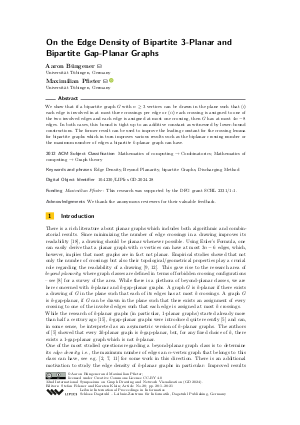LIPIcs.GD.2024.28.pdf
- Filesize: 1.25 MB
- 21 pages

 Creative Commons Attribution 4.0 International license
Creative Commons Attribution 4.0 International license

We show that if a bipartite graph G with n ≥ 3 vertices can be drawn in the plane such that (i) each edge is involved in at most three crossings per edge or (ii) each crossing is assigned to one of the two involved edges and each edge is assigned at most one crossing, then G has at most 4n-8 edges. In both cases, this bound is tight up to an additive constant as witnessed by lower-bound constructions. The former result can be used to improve the leading constant for the crossing lemma for bipartite graphs which in turn improves various results such as the biplanar crossing number or the maximum number of edges a bipartite k-planar graph can have.



Feedback for Dagstuhl Publishing